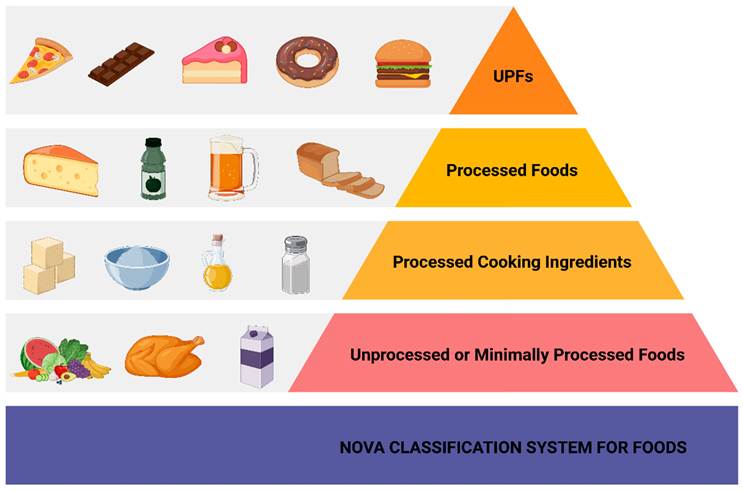Why is it in News?
- A Lancet Series on Ultra-Processed Foods and Human Health highlights India as the fastest-growing market for UPFs, with sales rising 150% in 15 years.
- Study warns that UPFs are driving obesity, diabetes, cardiovascular diseases, and poor nutrition.
- Lancet authors call for mandatory front-of-pack labels (FoPL) warning about high sugar, salt, fat — similar to Brazil and Chile.
- Debate intensifies as India considers FoPL regulations under FSSAI, amid rising marketing of unhealthy foods.
Relevance
- GS2: Governance – FSSAI regulation, public health policy, nutrition governance.
- GS2: Social Justice – child nutrition, NCD burden, food industry influence.
- GS3: Health – obesity, diabetes, cardio-metabolic diseases, gut microbiome impacts.

Basics
What are Ultra-Processed Foods (UPFs)?
- Industrial formulations made largely from refined ingredients:
- industrial starches
- extracted sugars
- refined oils
- protein isolates
- Contain additives: emulsifiers, stabilisers, artificial flavours, colourants.
- Examples: packaged snacks, instant noodles, soft drinks, flavoured yoghurts, frozen meals, ready-to-eat snacks.
Why are UPFs harmful?
- High in HFSS (High Fat, Sugar, Salt) → metabolic diseases.
- Low in fibre & micronutrients → malnutrition despite calorie surplus.
- Additives alter gut microbiome.
- Hyper-palatability → overeating & addiction-like food behaviours.
- Aggressive marketing → especially targets children.
Key Findings
- India: 150% UPF sales growth in 15 years.
- Global UPF market: $1 trillion; India UPF sales doubled since 2019.
- UPFs are replacing traditional, nutrient-dense diets rapidly.
- Consumption linked to rise in
- obesity
- type-2 diabetes
- cardiovascular diseases
- childhood obesity
- brain-health issues (behaviour, cognition)
- Need regulatory framework overriding industry influence.
UPFs and Children
- Children’s diet: over 50% UPF consumption in urban areas (survey-based).
- Early exposure →
- taste preference shifts toward sugar/fat
- addictive eating patterns
- impaired gut microbiome
- lower immunity
- poor neuro-development
- School canteens and home snacks dominated by UPFs.
Challenges in Elimination
- Aggressive food industry marketing (influencers, celebrities).
- Ambiguous nutrition labels that hide HFSS levels.
- Low awareness among parents about health impacts.
- Weak regulation of food additives and child-targeted advertising.
- High affordability & convenience compared to fresh foods.
- Absence of mandatory front-of-pack warnings.
What India must to do?
Mandatory Front-of-Pack Warning Labels (FoPL)
- Clear symbols for High in Sugar, High in Salt, High in Saturated Fat.
- Should follow WHO/PAHO guidelines.
- Not branding gimmicks (“high protein”, “low fat”) but warning labels.
Regulate UPF Advertising
- Ban HFSS ads targeting children (Brazil/Chile model).
- Restrict celebrity/influencer endorsements.
Reform School Canteen Regulations
- Replace UPFs with whole foods.
- Mandatory compliance audits.
Public Awareness Campaigns
- Focus on metabolic diseases, obesity, and children’s diet dangers.
Nutrient Profiling System
- Classify foods as: healthy, HFSS, UPF for regulatory decisions.
Promote Traditional Diets
- Millets, legumes, fresh fruits/vegetables under PM POSHAN, ICDS, PDS.
Identifying UPFs?
- More than 5–6 ingredients? Likely UPF.
- Contains emulsifiers, stabilisers, colourants, flavours? UPF.
- Package claims “high protein”, “low fat” while having additives? UPF.
- Shape/texture/flavour not naturally occurring? UPF.
Health Impacts
- Obesity epidemic.
- Insulin resistance & diabetes surge (India = global diabetes capital).
- Non-communicable diseases (NCDs) accelerating.
- Behavioural issues linked to gut dysbiosis.
- Poor academic performance among children.
- Premature mortality due to cardiovascular diseases.



